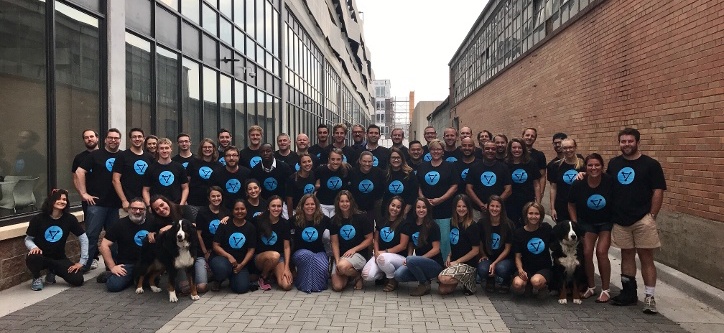By Hannah Shain, Director of Marketing at Cloud Elements
Q: What did the bartender say when oxygen, hydrogen, sulfur, sodium and phosphorous walked into his bar?
A: OH SNaP!
(That joke will make sense soon…)
If you’ve visited the Cloud Elements website lately, you may have noticed a new look and feel. That’s because Cloud Elements is five years old, and to mark the anniversary we rolled out a new logo and branding!
While the results look polished and pristine, getting there was no small feat. After all, how does a company introduce a new logo and branding to represent a new identity while also sustaining its core values and culture? Here’s what we learned through our rebranding.
Approaching the rebrand
Despite what some may think, rebranding is a fickle business. At a startup especially, there are countless opinions and ideas that have to be taken into account, and countless hours spent in creative workshops (also known as really long meetings with plenty of snacks to keep people happy).
Going into the rebranding process, we first came up with a theme that was consistent with our company brand: chemistry (Cloud Elements – get it?). Our project name for our new look came to be known as the “Science-y Rebrand,” and things took off from there.
Who are we?
Once we knew that science would be central to Cloud Elements’ new look, we examined the reputation and values we established over the last five years.
We like to call ourselves the new kids on the block. Hip. Fun. Playful. (This, in a lot of ways, helps us be the polar opposite of other vendors we get compared to.) This intrinsic playfulness is one of two important values we wanted to hold true in the new branding.
 The other thing we wanted to hold on to when rebranding was playing off of “Elements,” as in periodic table elements. Internally, we dub each employee with their own element. New hires are given business cards that look like a periodic table element.
The other thing we wanted to hold on to when rebranding was playing off of “Elements,” as in periodic table elements. Internally, we dub each employee with their own element. New hires are given business cards that look like a periodic table element.
We knew this was a cool-factor (and, yes, a nerd-factor) of the Cloud Elements brand that we just couldn’t give up.
Ready to design!
With those prerequisites in mind, designing the new logo seemed one million times easier. The new logo seemed to take on the science metaphor on its own!
Of course in the process, we learned more than we ever wanted to learn about chemistry, elements, covalent bonds and ions. All this led to the understanding that covalent bonds are a symbol of integration. And we know all about integrations!
We knew this was the right path when Mark Geene, Cloud Elements CEO and co-founder, told us: “I’m really loving how our new logo is embracing the story behind chemical elements and the periodic table, and starting to show that covalent bonds are the symbol of integration.”
New branding, same brand
Are you ready for the big reveal? Drum roll, please...
Old Logo:

New Logo:

Ta da!
The biggest takeaway we learned from rebranding: a different look doesn’t mean different values or goals. We’re still committed to making it faster and easier for developers to integrate with all the applications they use, as they connect data and create RESTful resources that can be interchangeable across any endpoint.
And of course, with the new logo, Cloud Elements clearly became an even more awesome company to work for! A few perks we won't be changing include unlimited vacation, Friday Ski Days and Hike Days, dog-friendly workspace and volunteering within the Denver Startup Community. (Pssst: We're hiring across the board at Cloud Elements, in sales, customer success and engineering. Check out our careers page to find a position that fits you.)
In the coming months, Cloud Elements’ graphics will undergo a steady, science-y rebrand transformation as we continue to delve deeper into the relationship between chemistry and API integrations.







